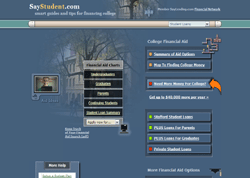What You Should Know About Private Student Loans
The cost of university education continues to outpace the consumer inflation rate, putting an even greater burden upon the shoulders of financially squeezed families. With annual education costs exceeding $30,000 or more at some universities, the financial burden is particularly profound even when some sort of assistance is made available.
Government student loans have long been an important way to help students complete their education with private student loans now gaining in importance too. Let’s take a look at the advantages and disadvantages of funding higher education through private student loans.
When it comes to college financing, often the sticker price is one thing, but the actual cost of education is something different. Depending on the aid offered, students can expect to receive anywhere from a full scholarship to not being offered any financial assistance. In most cases the cost of education lies somewhere in the middle once family income, assets, and other factors have been taken into account.
The amount remaining after financial aid has been factored in is what must be paid to the school, an amount that can vary each academic year. This gap is what often prompts families to consider financing options, with government-backed student loans being one option and private student loans another one.
Private student loans have several advantages to them including:
- Quick approval process:
In as little as five business days, a loan approval can be given with the funds made available directly to the student. With government student loans, processing is completed through the college.
- More money:
Usually, you can borrow more money privately than you can receive through government sources. The loan amount is usually capped at $30,000 annually or $40,000 when education costs exceed the $30,000 limit.
- More options:
Students can use private student loans to pay for a laptop computer and other education-related expenses. A government student loan is more restrictive.
- No government involvement:
A private student loan is just that ��" an agreement between you and a private lender. No government paperwork is filed because the funding is strictly private.
Although a private student loan has certain inherent advantages, the following disadvantages should be considered:
- Credit check required:
Only creditworthy individuals are eligible for a private student loan. In many cases a co-borrower (usually the parents) will have to co-sign the loan.
- Higher interest rate:
Private student loans charge a higher interest rate than government student loans. Rates are also variable, which means they can change up or down each month. Government student loans are fixed rate loans.
- Multiple applications required:
A private student loan must be applied for each academic year. That is also true for government student loans.
Unlike other forms of personal borrowing, a private student loan does not have to be paid back until after graduation. Just like a government student loan, grads have a 180 day grace period before the first loan payment is due.
Students should apply for the maximum amount of government student loans available. But when government student loans do not cover the entire cost of education, private student loans are a fast and flexible way to finance the remaining cost of higher education. While a government student loan is an attractive choice for many, private student loans offer a competitive alternative worthy of further exploration.
For information about the SayStudent Private Student Loan, click here.
About SayStudent.com
SayStudent.com is a comprehensive guide helping student and parents design the best financial aid option for financing college. Includes aid guides, aid charts, aid options and aid examples to educate and inform the public. Visit www.SayStudent.com for more information.

